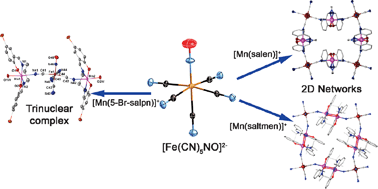Bimetallic cyanido-bridged magnetic materials derived from manganese(iii) Schiff-base complexes and pentacyanidonitrosylferrate(ii) precursor†
Abstract
Three heterobimetallic MnIIIFeII complexes: [Mn(5-Br-salpn)(H2O)]2[Fe(CN)5NO]·2H2O (1), [{Mn(salen)}2Fe(CN)5NO]·2H2O (2) and [{Mn(saltmen)}4Fe(CN)5NO](ClO4)2·H2O·2CH3OH (3), have been synthesized by the reactions of MnIII/Schiff–base (SB) complexes, [Mn(SB)(H2O)]+, (SB being salen2− = N,N′-ethylenebis(salicylideneiminato) dianion; 5-Br-salpn2− = N,N′-1,3-propylenebis(5-bromosalicylideneiminato) dianion or saltmen2− = N,N′-(1,1,2,2-tetramethylethylene) bis(salicylideneiminato) dianion) with the [Fe(CN)5NO]2− building block. ![[triple bond, length as m-dash]](https://www.rsc.org/images/entities/char_e002.gif) C–Fe–C
C–Fe–C![[triple bond, length as m-dash]](https://www.rsc.org/images/entities/char_e002.gif) N] bridges is systematically of antiferromagnetic nature: J/kB = −0.95(5) K and J/kB = −1.15(5) K for 1 and 2, respectively, while the direct MnIII–MnIII interaction, in the {Mn2(saltmen)2} dinuclear units present in 3, is ferromagnetic with J/kB = +1.75(5) K. Due to the ST = 4 spin ground state of these dinuclear units and the uniaxial magnetic anisotropy brought by the Mn(III) metal ions, 3 exhibits single-molecule magnet properties. The 400–900 nm optical properties of the three compounds have been also investigated, showing no significant photoactivity unlike in the Na2[Fe(CN)5NO] precursor.
N] bridges is systematically of antiferromagnetic nature: J/kB = −0.95(5) K and J/kB = −1.15(5) K for 1 and 2, respectively, while the direct MnIII–MnIII interaction, in the {Mn2(saltmen)2} dinuclear units present in 3, is ferromagnetic with J/kB = +1.75(5) K. Due to the ST = 4 spin ground state of these dinuclear units and the uniaxial magnetic anisotropy brought by the Mn(III) metal ions, 3 exhibits single-molecule magnet properties. The 400–900 nm optical properties of the three compounds have been also investigated, showing no significant photoactivity unlike in the Na2[Fe(CN)5NO] precursor.

- This article is part of the themed collection: 3rd International Symposium on Molecular Materials (MOLMAT)

 Please wait while we load your content...
Please wait while we load your content...